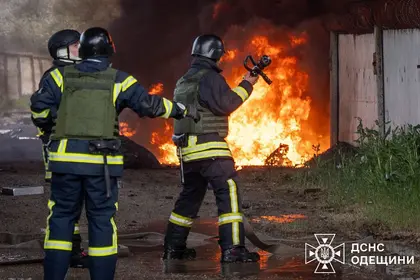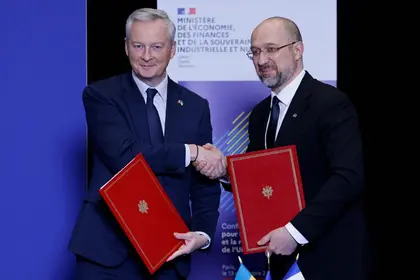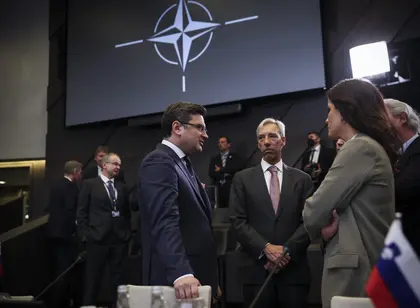For more than a year, Ukraine has suffered large-scale destruction as a result of Russian aggression. Since the beginning of the war, the country's economy has shrunk by almost a third. At present, Ukraine’s own funds are sufficient to finance military expenses, while social outlays are primarily provided by financial receipts from international partners.
In light of this, there is a need to form the clearest possible vision and a strong, predictable financial basis for the future post-war reconstruction of Ukraine.
A joint assessment released on March 23, 2023, by the government of Ukraine, the World Bank Group, the European Commission, and the United Nations, estimates that the cost of reconstruction and recovery in Ukraine has grown to $411 billion (the equivalent of €383 billion).
This estimate covers the one-year period from Russia's invasion of Ukraine on February 24, 2022, to the first anniversary of the war on February 24, 2023. The cost of reconstruction and recovery is expected to stretch over 10 years and combines the need for money from both public and private funds.
This second Rapid Damage and Needs Assessment (RDNA2) provides a comprehensive evaluation of war impacts across 20 different sectors. It quantifies the direct physical damage to infrastructure and buildings and describes the impact on people's lives and livelihoods. The RDNA2 also includes the amounts needed for recovery and reconstruction.

Massive Missile Attack Hits Odesa Region as Russian Troops Target Odesa with Ballistic Missiles
The RDNA2 estimates Ukraine will need $14 billion for critical and priority reconstruction and recovery investments in 2023.
Meeting these needs will require $11 billion in financing beyond what the government has already addressed in its 2023 budget, including $6 billion in unfunded budget needs and another $5 billion in financing to support state-owned enterprises (SOEs) and incentivize the private sector.
The RDNA2 assessment finds the total estimated reconstruction and recovery needs to be $411 billion.
This is 2.6 times the country's estimated 2022 GDP.
This assessed requirement - estimated for the next decade - considered inflation, market conditions, surge pricing in areas of mass construction, higher insurance premiums, and a shift in the future towards more energy efficient, more resilient and inclusive, and more modern design.
The highest estimated needs are in transport infrastructure(22 percent), housing (17 percent), energy (11 percent), social protection and general welfare (10 percent), explosive hazard management (9 percent), and agriculture (7 percent).
The largest proportion of increase was in energy, where damage was more than five times greater than in June 2022. The geographic areas with the greatest increase in needs are frontline regions of the war: Donetska, Kharkivska, Luhanska, and Khersonska.
Fast recovery
This stage of reconstruction is primarily related to meeting the needs of the population. It is about:
- housing restoration;
- reconstruction of critical infrastructure (electricity, heating, water supply, mobile communication, etc.);
- the humanitarian sphere (schools, hospitals, kindergartens);
- transport infrastructure (roads, bridges, railways, train terminals, airports, and seaports).
In January 2023 Government established the State Agency for Reconstruction and Development of Infrastructure of Ukraine based on Ukravtodor and the State Agency for Infrastructure Projects.
The scope of the Agency's responsibility goes beyond transport infrastructure and also covers the construction and reconstruction of residential facilities, social and public facilities, housing, energy infrastructure, etc.
As the head of the Agency Mustafa Nayem noted, priority will be given to projects in the most affected regions - Odesa, Mykolaiv, Zaporizhzhia, Kherson, Dnipropetrovsk, Donetsk, Kharkiv, Sumy, Chernihiv, Zhytomyr and Kyiv regions.
Recently, the President signed a law that introduces a compensation mechanism for Ukrainians for destroyed or damaged housing.
The sources of funding for these compensations are the Recovery Fund, state and local budgets, funds frominternational financial institutions, investors, and other international partners, as well as reparations and confiscated assets of the Russian Federation.
Sources of financing
The state budget is quite limited, thus for 2023, $1.4 billion is provided for the Fund for the Liquidation of the Consequences of the Russian Federation's Aggression.
At the end of January, the European Union launched a donor coordination platform for the recovery of Ukraine. The EU itself is ready to allocate €1 billion for rapid recovery projects.
Accumulation of funds for the recovery of Ukraine is also being conducted through the World Bank fund and the international special fund for energy recovery.
Individual countries are also organizing their own funds, which will go to post-war reconstruction. This will be done through the financing of foreign companies. International aid for Ukraine also comes via the official United24 fundraising platform.
Ukraine also counts on one more funding source - reparations from the Russian Federation and confiscated Russian assets.
But this prospect will only be possible later in the future, and counting on it this year makes no sense.
In 2022, the European Investment Bank (EIB) allocated €1.05 billion as part of the implementation of joint investment projects to finance measures to prepare housing and communal facilities for heating costs during the winter season.
Money also went to the restoration and modernization of road facilities damaged by hostilities, in particular artificial structures and railway infrastructure, and importantly - the supply of electricity, heatand water to residential and communal infrastructure facilities - while ensuring energy efficiency and energy savings.
During September and October 2022, EIB funds in the amount of €1 billion were transferred to a special fund of the state budget. At the same time, €50 million from the EIB loan funds were directed to the state enterprise "Ukrenergo" for financing auxiliary services, balancing the production and consumption of electric energy.
As part of the financing, €400 million was directed to the Ukravtodor to ensure measures to support the functioning of road management and transport infrastructure under martial law.
According to the Ministry of Finance, they are planning to allocate €600 million in 2023 for the design, restoration, construction, modernization, planning, and repair of building structures. This funding will primarily target the general public sphere – community life, cultural heritage, housing, and social services.
Among the priorities are engineering and transportation (public highways of state importance), railway, energy infrastructure, border crossing points with EU member states and Moldova, as well as the infrastructure of aviation, sea, and river transportation.
Viktor Dovhan was Deputy Minister of Infrastructure of Ukraine in 2016-2019
The views expressed in this opinion article are the author’s and not necessarily those of Kyiv Post.
You can also highlight the text and press Ctrl + Enter






Comments (0)